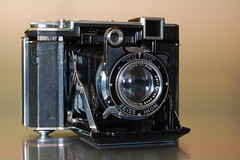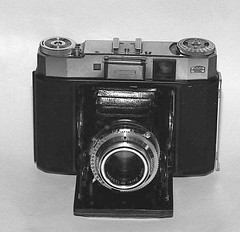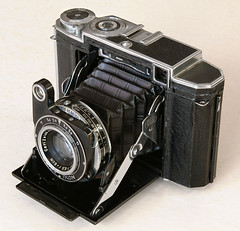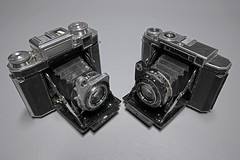Ikonta
Zeiss-Ikon's top product line of folding medium-format cameras were badged Ikonta and were generally of superior quality compared with corresponding folding camera models of Zeiss-Ikon's Nettar product line.
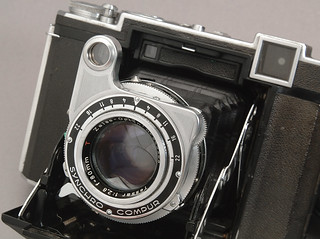
|
| Super Ikonta B 532/16 image by Geoff Harrisson (Image rights) |
Contents
History & Models
Launched in 1929, Ikontas were offered in four models: A, B, C, & D. The A, B, & C sizes took 120 film and produced negatives in 6x4.5 format, 6x6 format, and 6x9 format, respectively. The Ikonta D produced larger negatives on either 116 or 616 film. There was also a Baby Ikonta, which used 127 film. The first series of Ikonta were also labeled the 520 series. The A, B, & C models were also designated 520, 520/16, and 520/2, respectively.
About 1940 the 520 series gave way to the 521 series, which added a shutter release on the body and double exposure prevention. Only the A, B, & C models continued. In the early 1950s the 523 was launched for the B & C models. A chrome top plate with an integral finder and an accessory shoe was added. The 524 series added an uncoupled rangefinder and was also called the "Mess" Ikonta. Hubert Nerwin designed the Ikonta 35, a viewfinder camera, for 35mm film. Nerwin created versions with a rangefinder, the Contina with separate optical viewfinder, and the Contessa with a big optical viewfinder plus superimposed Super-Ikonta-like coupled rangefinder. The Ikonta 35 and the Contina were soon renamed Contina and Contina II.
In the United States early Ikontas were sold under the name Ikomat.
Super Ikonta
Variants which included a coupled rangefinder which were named Super Ikonta. The early Super Ikonta rangefinder cameras especially were copied by competitors and concurrents, as they included an ingenious way to couple the rangefinder by means of one optical element of the rangefinder mounted on the lens standard. An example of such a copy is the Moskva-2.
Super Ikonta model numbers began with a 530, followed by the 531 series.
The final Super Ikonta folders were the Super Ikonta III and Super Ikonta IV. Both were in 6x6 format and had the advantage of a film winding mechanism that allowed the film to be advanced without use of numbers in the red window. The only difference between the III and IV was that the latter had a selenium meter. Their catalog numbers were 531/16 and 534/16, respectively.
After World War II the Ikonta cameras were produced in West Germany's Zeiss-Ikon plant in Stuttgart. The East German Zeiss-Ikon in Dresden continued production of a traditional Ikonta model, naming it "Ercona".
The West German plant launched a 35mm Ikonta viewfinder model which was continued as Contina.
Lenses & Shutters
Ikontas were fitted with a wide range of lenses and shutters, and the cameras were originally priced accordingly. The primary difference between Ikontas and Nettar models was often the lens and shutter combination.
The lenses were f/6.3 Novar f/4.5 Novar, f/3.5 Novar, and f/3.5 Tessar. The focal length was 75mm for 6x6 format cameras and 105mm for 6x9. Novar lenses were a triplet design outsourced to another German optical company, typically Rodenstock or Steinheil. The f/6.3 Novar was dropped after the 520 series. Tessar lenses were a 4-element design made by Zeiss. They were uncommon on Ikonta or Mess Ikonta models and more often found on Super Ikontas.
Ikontas were also provided with a range of shutters, the simplest being a three-speed Klio on early models. Other shutters may include the Vario (3-speed), Prontor (4-speed), Prontor-S (8-speed), Compur (8-speed), and Synchro-Compur (10-speed).
Postwar Ikontas tended to have better shutters and lenses, as the cheaper combinations were relegated to the Nettar line.
Lenses after the war were coated, which reduced light reflections between the elements. Uncoated lenses may flare more often and can lead to distorted colors if used with modern color film. Postwar shutters usually had flash synchronization. Immediately after the war some models were fitted with Schneider Xenar lenses.
On all Ikontas focusing is performed by rotating the front lens (front lens focusing).
Ikonta Models
Ikonta Format 24x36mm
- Ikonta B 522/24 or Ikonta 35, see Contina
Ikonta Format 3x4cm
- Ikonta 520/18, 1931 to 1937
Also called the Baby Ikonta or Ikomat 520/18
Ikonta Format 4.5x6cm
- Ikonta A 520, 1932 to 1937
Also sold as the Ikomat A - Ikonta A 521, 1938 to 1954
Ikonta Format 5x7.5cm
- Ikonta 520/14, 1930 to 1931
Ikonta Format 6x6cm
- Ikonta B 520/16, 1937 to 1938
- Ikonta B 521/16, 1938 to 1951
- Ikonta B 523/16, 1952 to 1953
- Mess-Ikonta 524/16, 1951 to 1954
Also sold as the Ikonta-M 6x6
Ikonta Format 6x9cm
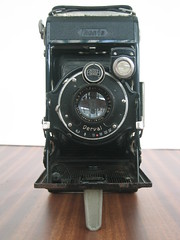
|
| c.1930 Ikonta C 520/2 with Novar lens and Telma shutter image by polbar (Image rights) |
- Ikonta C 520/2, 1929 to 1937
- Ikonta C 521/2, 1938 to 1952
- Ikonta C 523/2, 1952 to 1953
- Mess-Ikonta 524/2, 1951 to 1953
Also sold as the Ikonta-M 6x9
Ikonta Format 6.5x11cm
- Ikonta 520/15, 1931 to 1936
Also sold as the Ikomat D
Super Ikonta Models
Super Ikonta Format 4.5x6cm
- Super Ikonta A 530, 1934 to 1937
Also sold as the Super Ikomat A - Super Ikonta A 531, 1936 to 1953
Super Ikonta Format 6x6cm
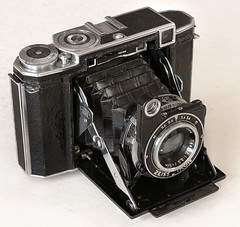
|
| Super Ikonta B 530/16 image by Geoff Harrisson (Image rights) |
- Super Ikonta B 530/16, 1935 to 1938
Also sold as the Super Ikomat B 21/4x21/4 - Super Ikonta B 532/16, 1937 to 1955
Also sold as the Super Ikonta I 6x6cm and Super Ikonta I 21/4x21/4 - Super Ikonta BX 533/16, 1939 to 1955
Also sold as the Super Ikonta II 6x6 cm and Super Ikonta II 21/4x21/4 - Super Ikonta III 531/16, 1953 to 1957
- Super Ikonta IV 534/16, 1955 to 1959
Super Ikonta Format 6x9cm
- Super Ikonta C 530/2, 1933 to 1939
Also sold as the Super Ikomat C 21/4x31/4 - Super Ikonta C 531/2, 1936 to 1953
Also sold as the Super Ikonta II 6x9 cm and Super Ikonta II 21/4x31/4
Super Ikonta Format 6.5x11cm
- Super Ikonta D 530/15, 1934 to 1938
Also sold as the Super Ikomat D
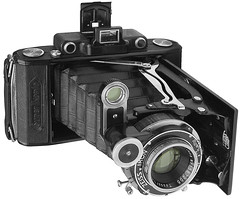
|
| Super Ikonta C 530/2 image by Alf Sigaro (Image rights) |
Images Ikonta viewfinder cameras

|
| Ikonta image by Arthur Kamst (Image rights) |

|
| Ikonta 2 image by polbar (Image rights) |
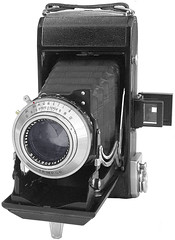
|
| Ercona image by Alf Sigaro (Image rights) |
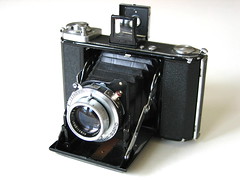
|
| Ikonta 521/16 image by Markus Berndt (Image rights) |
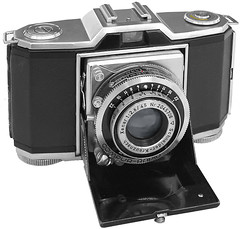
|
| Ikonta 522/24 (35mm) image by Alf Sigaro (Image rights) |
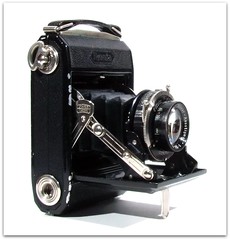
|
| Ikonta A image by Süleyman Demir (Image rights) |
Images Super Ikonta rangefinder cameras
|
|
|
|||||||
|
|
|
Links
General links
In English:
- Ikonta and Super Ikonta at Pacific Rim Camera
- Ikonta 520 A by luis triguez
- Super Ikonta C page at Aruku Camera
- Pages in David Richert's website (archived):
- Zeiss Ikonta family list at cameracollector.net
In French:
- Pages on www.collection-appareils.fr by Sylvain Halgand:
- Ikonta A 521 with Novar f/6.3
- Ikonta C 521/2 with Novar f/4.5
- Ikonta B 521/16 with Novar f/3.5
- Ikonta M 524/16 with Tessar f/3.5
- Ikonta C 520/2 with Novar f/4.8
- Ikonta D 520/15 with Novar f/6.3 and Telma
- Ikonta 522/24 with Novar f/3.5
- Super Ikonta A 530 with Tessar f/3.5
- Super Ikonta A 531 with Tessar f/3.5
- Super Ikonta B 530/16 with Tessar f/2.8 and distance in feet
- Super Ikonta B 532/16 with Tessar f/2.8 and Compur-Rapid
- Super Ikonta BX 533/16 with Tessar f/2.8 and Compur-Rapid
- Super Ikonta III 531/16 with Tessar f/3.5
- Super Ikonta IV 534/16 with Tessar f/3.5
- Super Ikonta C 530/2 with Tessar f/3.8 and Compur-Rapid
- Super Ikonta C 531/2 with Tessar f/3.5 and Compur-Rapid
- Super Ikonta D 530/15 with Tessar f/4.5 and Compur
Manuals and brochures
- Manuals and brochures in David Richert's website (archived):
